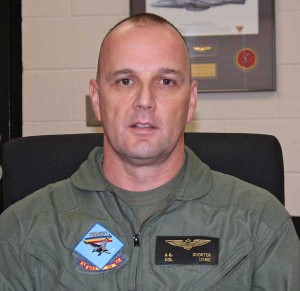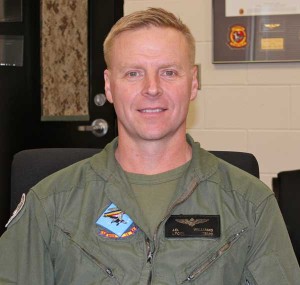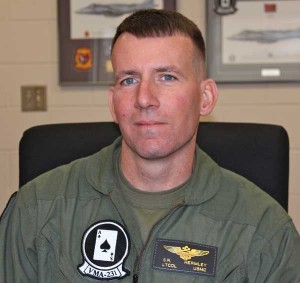01/26/2012 – During interviews conducted in Norfolk, VA and in Cherry Point, Second Line of Defense discussed with various combat elements involved in the forthcoming Bold Alligator 2012 exercise. In this piece, we discussed the preparations for the strike force off of the USS Kearsarge for the operation of 16 Harriers to provide for a significant part of the strike force.
The interview was conducted with Colonel Andrew “Shorty” Shorter, Commanding Officer, Marine Aircraft Group 14, MCAS Cherry point, Lieutenant Colonel “Uber” Williams, OIC Marine Aviation Training System Site – MCAS Cherry Point, and Lieutenant Colonel Shawn Hermley, Commanding Officer, Marine Attack Squadron 231, MCAS Cherry Point.

Col. Shorter explained the paradigm shift in using the Harriers off of the large deck amphibious ships involved in the exercise.
Col. Shorter: The use of the Harriers in the exercise is completely different from what we normally do, a different paradigm, if you will. Normally, a Harrier squadron breaks down as a squadron (minus) and detachment or Det that it chops out. After it chops the squad or after it chops the Det, it becomes squadron (minus). So within every Harrier squadron, there are by design two entities built into that.
Normally, we chop the Det out to the MEU/ACE as six planes and nine pilots. Normally, the base of that is the VMM squadron. Now here on East Coast, VMM squadrons are all V-22s. So those six Harriers become part of a VMM squadron along with Cobras and 53s as well. The squadron (minus) remains behind to continue to train pilots for the future and also as a deployable unit.
For the last going 10 years, we have deployed the squadron (minus) as what we like to call a MEF forward asset. In this case, they’ve been going to OIF or OEF for the same period. This means that, in effect, two operations have been going while the MEUs had been on these or the Dets have been also going on these MEU deployments.
In other words, the general construct is that the Harrier squadron breaks down Det squadron (minus). Where it’s different in Bold Alligator is that we’re going to take two squadron (minus) that already have their Dets out dedicated to MEUs.
We’re going to deploy them on a large deck amphib carrier to work as a single integrated strike force.
Obviously, it is a broader capability and deeper capability than what any MEU has at any one time. Instead of the normal six-Harrier Det, the strike force will nominally have 16 Harriers from the two squadrons (minus).
SLD: So you’re testing here something greater than the two MEUs trying to aggregate the assets into a single support element, single combat element. You’re experimenting with basically a much larger sea base support structure led by the amphibious fleet rather than led by the strike carrier.
Col. Shorter: Exactly. I guess you’d say that we like to have scalable capabilities, so we’re using a different scale on this case, and then we’re putting those two together to be ultimately flexible. We have the deck available so we put the two squadrons (minus) together at sea, which is normally something that we don’t do – squadrons (minus) at sea.
Usually it’s the MEU Dets at sea, although all the pilots are cross-trained to be able to do either. That’s one of our core mission tasks, it’s the expeditionary operations and operations from a sea base.
But we’re able to take these two entities that normally don’t deploy on the sea base, put them on the sea base in order to be agile in reaction to the requirement. In this case, the scenario that’s being played out in Bold Alligator demands such a capability.
SLD: In effect, this is bringing together with today’s assets a template for more strike capability, which is a template well, designed for the arrival of the F-35Bs.
***

Lt. Colonel Williams further discusses the paradigm shift involving the plus up of the Harrier strike force. We earlier talked with “Uber” at an exercise North Carolina at the end of August 2011. (Please see https://sldinfo.com/the-harrier-and-expeditionary-basing/ and https://sldinfo.com/harrier-exercise-at-marine-corps-air-station-beaufort/.)
In Bold Alligator 2012, the entire large deck Amphib will support the 16 fixed wing Harrier aircraft. As the Lt. Col. underscored, the flexibility demonstrated by the Harriers on the large deck Amphib will be exercised.
In Bold Alligator 2012, the entire large deck Amphib will support the 16 fixed-wing Harrier aircraft. As the Lt. Col. underscored, the flexibility demonstrated by the Harriers on the large deck Amphib will be exercised. .
SLD: What is your role in the exercise?
Lt. Col. Williams: I’m serving as Col. Shorter’s deputy from MAG-14 headquarters. While he’s back in Cherry Point running the rest of his MAG, I will be out aboard the Kearsarge basically as his deputy or the higher headquarters specifically to assist the Harrier squadrons connected to the ACE Command Element.
SLD: The USMC has a lot of experience with ARGs and MEUs. Now you’re aggregating capabilities to support a larger battle space or providing a larger configuration force. Talk a little bit about how it will get exercised and how it allows the USN-USMC team to rethink how you use these assets?
Lt. Col. Williams: The MEUs that we put out every year have actually a somewhat small sampling of AV-8Bs – six Harriers, nine pilots, 74 Marines. That amount of capability is somewhat limited compared to what we’re going to put out for Bold Alligator, which is an entire deck dedicated to Harrier operations with 16 airplanes.
That provides a lot of flexibility, and I think that what you see when you go out and put nothing but fixed wing on the amphib, you can do a lot of different things. The missions that we’re going to do and the deck cycle we’ll run is varied from day to day.
The first couple of days that we go out, we’ll be shaping with integration with the F-18s from down at Beaufort and prepping battlefields so to speak. And then we will transition from that phase into a sortie of generation phase where we will demonstrate and practice the flexibility and responsiveness that STOVL brings.
If we’re close to the beach, we can get there and support that maneuver force going ashore and get back, not only to refuel but re-arm and get right back out the battle space.
Immediately after that, we transition. Again, this is training, but we will then do long-range strikes again partnering up with shore-based F-18s, and at the same time, we’re partnering up with our V-22s that are coming off of the Wasp to do a long-range raid all the way up to Virginia.
The flexibility demonstrated by having 16 AV-8s on a carrier dedicated to them is that we’re sweeping the breadth of the East Coast, and we’re sweeping the breadth of missions almost on a daily basis.
And I think one of the really exciting things is that we are going back to the vision of a VSTOL or a STOVL force, and we’re seeing the execution of that with STOVL fixed-wing aircraft, squadrons of STOVL fixed-wing aircraft to float and embark, and squadrons of V-22s afloat.
The proximity to the battle space and the capability that is demonstrated there is phenomenal because in terms of speed, responsiveness, range, depth, and capabilities it’s really exciting to see as we go into this exercise.
SLD: In effect, this is bringing together with today’s assets a template for more strike capability, which is a template well, designed for the arrival of the F-35Bs. Besides providing the deck off of which the Harrier strike force of 16 aircraft will operate, the USS Kearsarge will be managing a large part of the air battle management in support of the insertion of force during the Bold Alligator exercise.
***

In this part of the interview, Lt. Colonel Shawn Hermley, discusses the role of the air traffic control function aboard the USS Kearsarge. Hermley was recently involved with the 26th MEU in operations off of Libya as a Harrier pilot and speaks from experience.
The USS Kearsarge will be handling the various air assets of the force insertion. It will be sharing the C2 role with the Aegis and the large deck carrier. The USS Kearsarge in Libya they were the only ship providing radar; now the challenge will be part of the sector.
SLD: How was the Kearsarge used in Operation Odyssey Dawn?
Lt. Col. Hermley: We had 6 Harriers aboard the Kersarge at the start of Operation Odyssey Dawn. But at the start of the operation, there were limited radars or air control assets available to operate a strike force. The USS Kersarge ended up playing a key role in this regard for the first 7 days of the operation.
The tactical air command center aboard the Kersarge basically does all the command and control aboard the ship. So they’re identifying primary foes as ship or as aircraft approaches the ship.
It is small and about the size of this room. They have a small handful of people. They have a watch captain that’s usually an O3, so a Navy lieutenant or a Navy lieutenant commander; a few of those with them, and then sailors that are working the scopes.
They’re looking at the air picture piece while when you go in the combat information center or combat intelligence center or CIC. They’re looking at the air and surface piece.
With the Kearsarge being the closest U.S. asset and the only asset that had the air control capability equipment on board, the radios and the rest of it and the links into the big air picture and the tie in with the CAOC, whenever there was not an airborne C2 on station, the Kearsarge was controlling all of the air into and out of Libya or the airspace in Libya.
So for the first seven days, The TACRON Det on the Kearsarge was controlling all the air traffic. At that point, it was just mostly intelligence platforms. But the Kearsarge was the only airborne radar that was even close to Libya at that time.
SLD: How will it be different in Bold Alligator 2012?
Lt. Col. Hermley: I think the biggest difference is going to be the responsibilities and the division responsibilities in that air control piece with a big deck carrier out there or an H class cruiser. That bigger umbrella is going to be controlled by them and the Kearsarge is going to fit into a certain portion of that.
The difference in Libya was they were it. They had it; it was a direct link. The only ship with a radar to be able to provide any kind of air control was coming from the Kearsarge and they were it.
And I think in Bold Alligator, their challenge they’re going to have there is fitting in to all the sectors and then becoming part of that whole big picture.
SLD: Presumably, they’re handling the 165-mile insertion piece, so to speak or somewhat like Libya where they were managing this grid however will be supporting insurgent forces and the air assets; carrying those forces and supporting those forces. Is that a fair statement?
Lt. Col. Hermley: It is fair and they will certainly face be a bigger challenge for them in that respect as far as forces ashore and then facing control ashore. That was an aspect they didn’t have to deal with during Libya since we didn’t put any forces ashore.
They’re not going to be the top dog or the only game in town like they were in Libya when it comes to the air control piece. Now they will have to fit into a bigger air control piece as well as dealing with the forces ashore. So that would be a bigger challenge for them and will require meeting the challenge of fitting into a larger structure.

